基于Springboot和mybatis的外卖项目瑞吉外卖Day5
Posted 小小程序○
tags:
篇首语:本文由小常识网(cha138.com)小编为大家整理,主要介绍了基于Springboot和mybatis的外卖项目瑞吉外卖Day5相关的知识,希望对你有一定的参考价值。
瑞吉外卖Day5
新增套餐
将新增页面录入的套餐信息插入到setmeal表,同时向setmeal_dish表插入套餐和菜品关联数据。
新增套餐涉及到两个表:
- setmeal 套餐表
- setmeal_dish 套餐菜品关系表
一、类和接口的基本结构
- 实体类SetmealDish
- DTO SetmealDto
- Mapper接口 SetmealDishMapper
- 业务层接口 SetmealDishService
- 业务层实现类SetmealDishServicelmpl
- 控制层 SetmealController
二、前端页面交互过程
- 页面(backend/page/combo/add.html)发送ajax请求,请求服务端获取套餐分类数据并展示到下拉框中
- 页面发送ajax请求,请求服务端获取菜品分类数据并展示到添加菜品窗口中
- 页面发送ajax请求,请求服务端,根据菜品分类查询对应的菜品数据并展示到添加菜品窗口中
- 页面发送请求进行图片上传,请求服务端将图片保存到服务器
- 页面发送请求进行图片下载,将上传的图片进行回显
- 点击保存按钮,发送ajax请求,将套餐相关数据以json形式提交到服务端
三、代码实现
1.实体类SetmealDish
package com.study.pojo;
import com.baomidou.mybatisplus.annotation.FieldFill;
import com.baomidou.mybatisplus.annotation.TableField;
import lombok.Data;
import java.io.Serializable;
import java.math.BigDecimal;
import java.time.LocalDateTime;
/**
* 套餐菜品关系
*/
@Data
public class SetmealDish implements Serializable
private static final long serialVersionUID = 1L;
private Long id;
//套餐id
private Long setmealId;
//菜品id
private Long dishId;
//菜品名称 (冗余字段)
private String name;
//菜品原价
private BigDecimal price;
//份数
private Integer copies;
//排序
private Integer sort;
@TableField(fill = FieldFill.INSERT)
private LocalDateTime createTime;
@TableField(fill = FieldFill.INSERT_UPDATE)
private LocalDateTime updateTime;
@TableField(fill = FieldFill.INSERT)
private Long createUser;
@TableField(fill = FieldFill.INSERT_UPDATE)
private Long updateUser;
//是否删除
private Integer isDeleted;
2.Mapper接口 SetmealDishMapper
package com.study.mapper;
import com.baomidou.mybatisplus.core.mapper.BaseMapper;
import com.study.pojo.SetmealDish;
import org.apache.ibatis.annotations.Mapper;
@Mapper
public interface SetmealDishMapper extends BaseMapper<SetmealDish>
3.业务层接口 SetmealDishService
package com.study.service;
import com.baomidou.mybatisplus.extension.service.IService;
import com.study.pojo.SetmealDish;
public interface SetmealDishService extends IService<SetmealDish>
4.业务层实现类SetmealDishServicelmpl
package com.study.Service.impl;
import com.baomidou.mybatisplus.extension.service.impl.ServiceImpl;
import com.study.Service.SetmealDishService;
import com.study.mapper.SetmealDishMapper;
import com.study.pojo.SetmealDish;
import lombok.extern.slf4j.Slf4j;
import org.springframework.stereotype.Service;
@Service
@Slf4j
public class SetmealDishServiceimpl extends ServiceImpl<SetmealDishMapper, SetmealDish> implements SetmealDishService
5.控制层 SetmealController
package com.study.controller;
import com.baomidou.mybatisplus.core.conditions.query.LambdaQueryWrapper;
import com.baomidou.mybatisplus.extension.plugins.pagination.Page;
import com.study.Dto.SetmealDto;
import com.study.Service.CategoryService;
import com.study.Service.SetmealDishService;
import com.study.Service.SetmealService;
import com.study.common.R;
import com.study.pojo.Category;
import com.study.pojo.Setmeal;
import lombok.extern.slf4j.Slf4j;
import org.springframework.beans.BeanUtils;
import org.springframework.beans.factory.annotation.Autowired;
import org.springframework.util.StringUtils;
import org.springframework.web.bind.annotation.*;
import java.util.Arrays;
import java.util.List;
import java.util.stream.Collectors;
@RestController
@RequestMapping("/setmeal")
@Slf4j
public class SetmealController
@Autowired
private SetmealService setmealService;
/**
* 新增套餐
* @param setmealDto
* @return
*/
@PostMapping
public R<String> save(@RequestBody SetmealDto setmealDto)
log.info("套餐信息:",setmealDto);
setmealService.saveWithDish(setmealDto);
return R.success("新增套餐成功");
分页查询
一、前端和服务端交互过程
- 页面(backend/page/combo/list.html)发送ajax请求,将分页查询参数(page、pageSize、name)提交到服务端,获取分页数据页面发送请求
- 请求服务端进行图片下载,用于页面图片展示开发套餐信息分页查询功能
二、代码实现
SetmealController类中增添以下代码
/**
* 套餐分页查询
* @param page
* @param pageSize
* @param name
* @return
*/
@GetMapping("/page")
public R<Page> page(int page,int pageSize,String name)
Page<Setmeal> pageInfo=new Page<>();
Page<SetmealDto> dtoPage=new Page<>();
LambdaQueryWrapper<Setmeal> queryWrapper=new LambdaQueryWrapper<>();
queryWrapper.like(name!=null,Setmeal::getName,name);
queryWrapper.orderByDesc(Setmeal::getUpdateTime);
setmealService.page(pageInfo,queryWrapper);
BeanUtils.copyProperties(pageInfo,dtoPage,"records");
List<Setmeal> records=pageInfo.getRecords();
List<SetmealDto> list=records.stream().map((item)->
SetmealDto setmealDto=new SetmealDto();
BeanUtils.copyProperties(item,setmealDto);
Long categoryId = item.getCategoryId();
Category category=categoryService.getById(categoryId);
if(category!=null)
String categoryName=category.getName();
setmealDto.setCategoryName(categoryName);
return setmealDto;
).collect(Collectors.toList());
dtoPage.setRecords(list);
return R.success(dtoPage);
删除功能
一、前后端交互过程
1、删除单个套餐时,页面发送ajax请求,根据套餐id删除对应套餐
Request URL: http://localhost:8080/setmeal?ids=1414118011303899137
Request Method: DELETE
2、删除多个套餐时,页面发送ajax请求,根据提交的多个套餐id删除对应套餐
Request URL: http://localhost:8080/setmeal?ids=1414131634248101890,1414118011303899137
Request Method: DELETE
二、代码开发
SetmealController类中增添以下代码
/**
* 套餐删除
* @param ids
* @return
*/
@DeleteMapping
public R<String> delete(@RequestParam List<Long> ids)
log.info("ids:",ids);
setmealService.removeWithDish(ids);
return R.success("套餐删除成功");
完善其他功能
一、查询功能
@GetMapping("list")
public R<List<Setmeal>> list(Setmeal setmeal)
log.info("setmeal:",setmeal);
LambdaQueryWrapper<Setmeal> queryWrapper=new LambdaQueryWrapper<>();
queryWrapper.like(!StringUtils.isEmpty(setmeal.getName()),Setmeal::getName,setmeal.getName());
queryWrapper.eq(null!=setmeal.getCategoryId(),Setmeal::getCategoryId,setmeal.getCategoryId());
queryWrapper.eq(null!=setmeal.getStatus(),Setmeal::getStatus,setmeal.getStatus());
queryWrapper.orderByDesc(Setmeal::getUpdateTime);
return R.success(setmealService.list(queryWrapper));
二、修改套餐状态功能
@PostMapping("/status/st")
public R<String> setStatus(@PathVariable int st, String ids)
//处理string 转成Long
String[] split = ids.split(",");
List<Long> idList = Arrays.stream(split).map(s -> Long.parseLong(s.trim())).collect(Collectors.toList());
//将每个id new出来一个Dish对象,并设置状态
List<Setmeal> setmeals = idList.stream().map((item) ->
Setmeal dish = new Setmeal();
dish.setId(item);
dish.setStatus(st);
return dish;
).collect(Collectors.toList()); //Dish集合
log.info("status ids : ",ids);
setmealService.updateBatchById(setmeals);//批量操作
return R.success("操作成功");
阿里云平台
一、平台步骤
登录阿里云–>短信服务–>免费开通–>Accesskey管理设置key–>申请签名和模板
二、JavaAPI
package com.study.utils;
import com.aliyuncs.DefaultAcsClient;
import com.aliyuncs.IAcsClient;
import com.aliyuncs.dysmsapi.model.v20170525.SendSmsRequest;
import com.aliyuncs.dysmsapi.model.v20170525.SendSmsResponse;
import com.aliyuncs.exceptions.ClientException;
import com.aliyuncs.profile.DefaultProfile;
/**
* 短信发送工具类
*/
public class SMSUtils
/**
* 发送短信
* @param signName 签名
* @param templateCode 模板
* @param phoneNumbers 手机号
* @param param 参数
*/
public static void sendMessage(String signName, String templateCode,String phoneNumbers,String param)
DefaultProfile profile = DefaultProfile.getProfile("cn-hangzhou", "LTAI5tQVLLFZqKHYFZ9qxpvk",
"bpZLPBlvZ4ZOpgoC5Ru6pRVBTZgd7S");
IAcsClient client = new DefaultAcsClient(profile);
SendSmsRequest request = new SendSmsRequest();
request.setSysRegionId("cn-hangzhou");
request.setPhoneNumbers(phoneNumbers);
request.setSignName(signName);
request.setTemplateCode(templateCode);
request.setVersion("2017-05-25");
request.setTemplateParam("\\"code\\":\\""+param+"\\"");
try
SendSmsResponse response = client.getAcsResponse(request);
System.out.println("短信发送成功");
catch (ClientException e)
e.printStackTrace();
package com.study.utils;
import java.util.Random;
/**
* 随机生成验证码工具类
*/
public class ValidateCodeUtils
/**
* 随机生成验证码
* @param length 长度为4位或者6位
* @return
*/
public static Integer generateValidateCode(int length)
Integer code =null;
if(length == 4)
code = new Random().nextInt(9999);//生成随机数,最大为9999
if(code < 1000)
code = code + 1000;//保证随机数为4位数字
else if(length == 6)
code = new Random().nextInt(999999);//生成随机数,最大为999999
if(code < 100000)
code = code + 100000;//保证随机数为6位数字
else
throw new RuntimeException("只能生成4位或6位数字验证码");
return code;
/**
* 随机生成指定长度字符串验证码
* @param length 长度
* @return
*/
public static String generateValidateCode4String(int length)
Random rdm = new Random();
String hash1 = Integer.toHexString(rdm.nextInt());
String capstr = hash1.substring(0, length);
return capstr;
瑞吉外卖项目 基于spring Boot+mybatis-plus开发 超详细笔记,有源码链接
本项目是基于自学b站中 黑马程序员 的瑞吉外卖项目:视频链接:
黑马程序员Java项目实战《瑞吉外卖》,轻松掌握springboot + mybatis plus开发核心技术的真java实战项目_哔哩哔哩_bilibili https://www.bilibili.com/video/BV13a411q753?spm_id_from=333.337.search-card.all.click这篇博客是记录自己学习该项目的markdown笔记;并且自己把视频中一些没实现的功能给实现了;本人技术可能不到位,笔记仅供参考学习使用;
https://www.bilibili.com/video/BV13a411q753?spm_id_from=333.337.search-card.all.click这篇博客是记录自己学习该项目的markdown笔记;并且自己把视频中一些没实现的功能给实现了;本人技术可能不到位,笔记仅供参考学习使用;
本人自己把视频中老师没讲的一些功能给实现了,比如,后台按条件查询客户订单,用户个人查询自己的订单,菜品,套餐的启售,停售,购物车中菜品或者是套餐数量减少,后台套餐的修改。代码不一定规范,但是功能是没问题的!!!
项目中的资料下载链接:(从黑马公众号获取到的最初状态的源码,后面自己补充了一些课程没讲的功能,功能的实现代码在我博客的笔记中有)
链接:https://pan.baidu.com/s/1cdHI5cDjyHKZ4_0GmIevnQ
提取码:668a
目录
菜品信息分页查询(功能完善里面的代码要熟悉,有集合泛型的转换,对象copy)
一、项目背景介绍



技术选型:



二、软件开发整体介绍
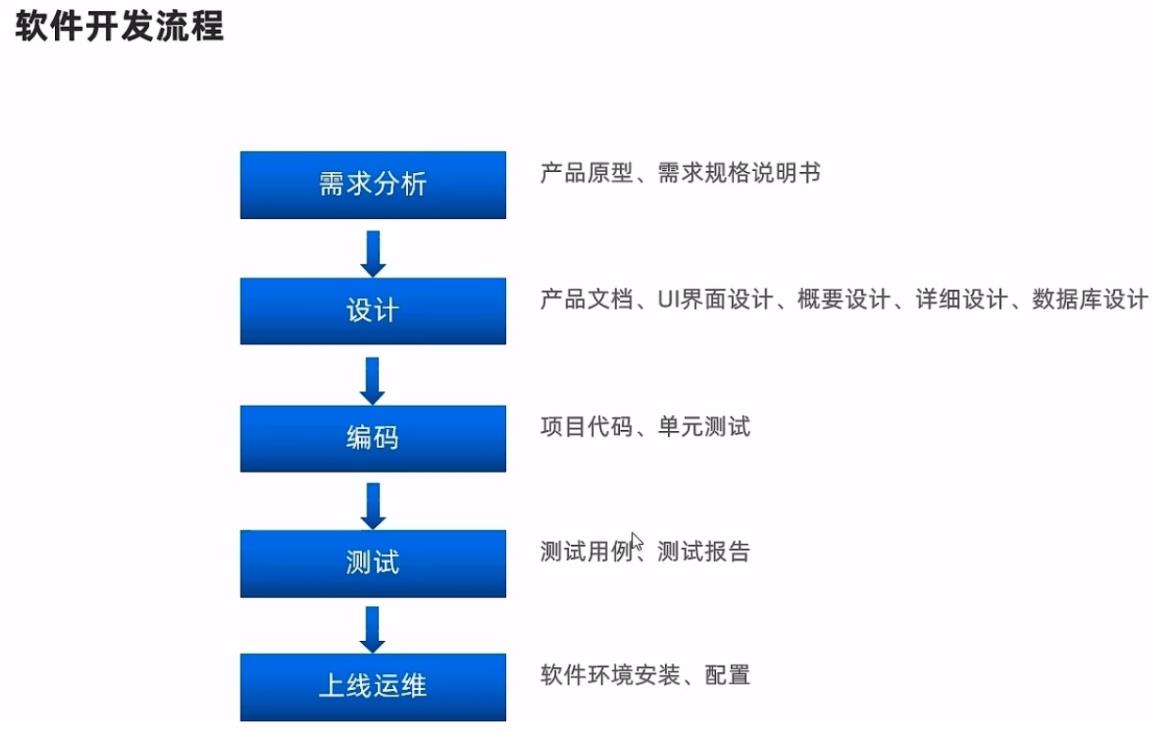

三、开发环境的搭建
①数据库环境的搭建
1.创建数据库:
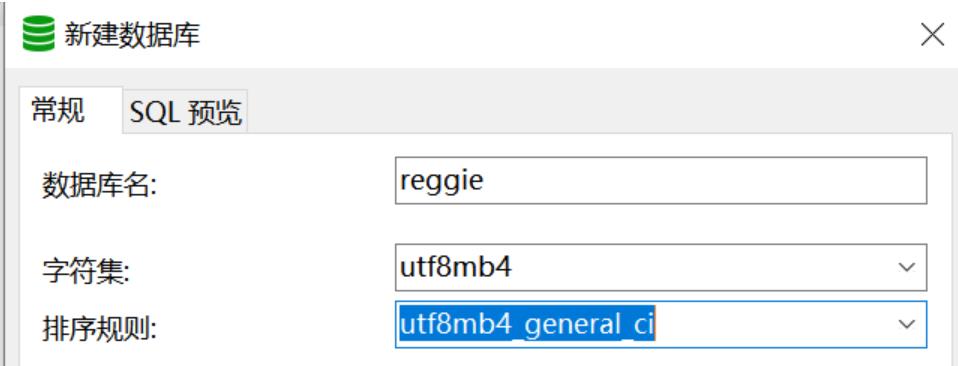
2.导入表结构,直接运行外部SQL文件;
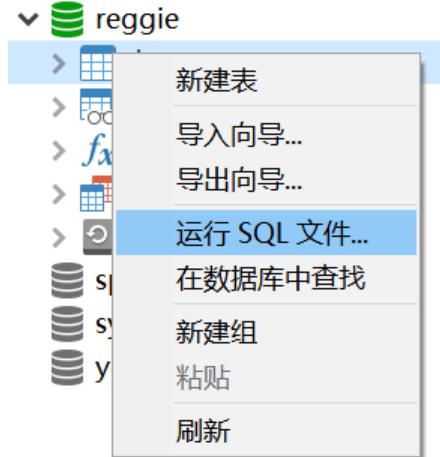
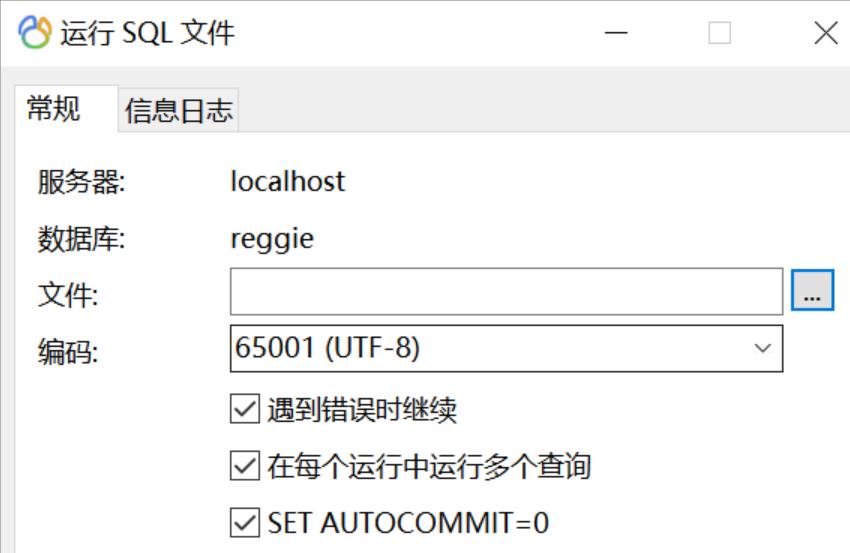
数据表的说明:
| 序号 | 表名 | 说明 |
|---|---|---|
| 1 | employee | 员工表 |
| 2 | category | 菜品和套餐分类表 |
| 3 | dish | 菜品表 |
| 4 | setmeal | 套餐表 |
| 5 | setmeal_dish | 套餐菜品关系表 |
| 6 | dish_flavor | 菜品口味关系表 |
| 7 | user | 用表(c端) |
| 8 | address_book | 地址薄表 |
| 9 | shopping_cart | 购物车表 |
| 10 | orders | 订单表 |
| 11 | orders_detail | 订单明细表 |
②maven项目搭建
1.创建一个maven项目

注意:创建maven项目后,一定要检查项目的编码,maven仓库的配置,jdk的配置等;



2.导入pom文件
<?xml version="1.0" encoding="UTF-8"?>
<project xmlns="http://maven.apache.org/POM/4.0.0"
xmlns:xsi="http://www.w3.org/2001/XMLSchema-instance"
xsi:schemaLocation="http://maven.apache.org/POM/4.0.0 http://maven.apache.org/xsd/maven-4.0.0.xsd">
<modelVersion>4.0.0</modelVersion>
<parent>
<groupId>org.springframework.boot</groupId>
<artifactId>spring-boot-starter-parent</artifactId>
<version>2.6.6</version>
<relativePath/> <!-- lookup parent from repository -->
</parent>
<groupId>com.itheima</groupId>
<artifactId>reggie_take_out</artifactId>
<version>1.0-SNAPSHOT</version>
<properties>
<maven.compiler.source>8</maven.compiler.source>
<maven.compiler.target>8</maven.compiler.target>
</properties>
<dependencies>
<dependency>
<groupId>org.springframework.boot</groupId>
<artifactId>spring-boot-starter</artifactId>
</dependency>
<dependency>
<groupId>org.springframework.boot</groupId>
<artifactId>spring-boot-starter-test</artifactId>
<scope>test</scope>
</dependency>
<dependency>
<groupId>org.springframework.boot</groupId>
<artifactId>spring-boot-starter-web</artifactId>
<scope>compile</scope>
</dependency>
<dependency>
<groupId>com.baomidou</groupId>
<artifactId>mybatis-plus-boot-starter</artifactId>
<version>3.4.2</version>
</dependency>
<dependency>
<groupId>org.projectlombok</groupId>
<artifactId>lombok</artifactId>
<version>1.18.20</version>
</dependency>
<dependency>
<groupId>com.alibaba</groupId>
<artifactId>fastjson</artifactId>
<version>1.2.76</version>
</dependency>
<dependency>
<groupId>commons-lang</groupId>
<artifactId>commons-lang</artifactId>
<version>2.6</version>
</dependency>
<dependency>
<groupId>mysql</groupId>
<artifactId>mysql-connector-java</artifactId>
<scope>runtime</scope>
</dependency>
<dependency>
<groupId>com.alibaba</groupId>
<artifactId>druid-spring-boot-starter</artifactId>
<version>1.1.23</version>
</dependency>
</dependencies>
<build>
<plugins>
<plugin>
<groupId>org.springframework.boot</groupId>
<artifactId>spring-boot-maven-plugin</artifactId>
<version>2.6.6</version>
</plugin>
</plugins>
</build>
</project>3.创建application.yml文件:
server:
port: 8080
spring:
application:
# 应用的名称,选择性配置
name: reggie_take_out
datasource:
druid:
driver-class-name: com.mysql.cj.jdbc.Driver
url: jdbc:mysql://localhost:3306/reggie?serverTimezone=Asia/Shanghai&useUnicode=true&characterEncoding=utf-8&zeroDateTimeBehavior=convertToNull&useSSL=false&allowPublicKeyRetrieval=true
username: root
password: root
mybatis-plus:
configuration:
#在映射实体或者属性时,将数据库中表名和字段名中的下划线去掉,按照驼峰命名法映射
map-underscore-to-camel-case: true
# 把SQL的查询的过程输出到控制台
log-impl: org.apache.ibatis.logging.stdout.StdOutImpl
global-config:
db-config:
id-type: ASSIGN_ID3.创建Boot程序入口
package com.itheima.reggie;
import lombok.extern.slf4j.Slf4j;
import org.springframework.boot.SpringApplication;
import org.springframework.boot.autoconfigure.SpringBootApplication;
/**
* @author LJM
* @create 2022/4/14
*/
@Slf4j
@SpringBootApplication
@ServletComponentScan
public class ReggieApplication
public static void main(String[] args)
SpringApplication.run(ReggieApplication.class,args);
log.info("项目启动成功...");
4.运行Boot程序,看是否成功;
③导入前端文件
注意前端文件的位置,在Boot项目中,前台默认就只能访问 resource目录下的static和template文件夹下的文件;所以如果要使用这种方式,直接创建一个static目录就行,然后把这些前端资源放在这个static目录下就行;
如果你不想把前端文件放在这两个默认的文件夹下,那么就可以自己定义mvc的支持,这里我们使用的就是这方式;(多学习一种定义的方法,以后自定义映射的时候可以使用)

package com.itheima.reggie.config;
import lombok.extern.slf4j.Slf4j;
import org.springframework.context.annotation.Configuration;
import org.springframework.web.servlet.config.annotation.ResourceHandlerRegistry;
import org.springframework.web.servlet.config.annotation.WebMvcConfigurationSupport;
/**
* @author LJM
* @create 2022/4/14
*/
@Slf4j
@Configuration
public class WebMvcConfig extends WebMvcConfigurationSupport
/**
* 设置资源映射
* @param registry
* 前面表示的是浏览器访问的请求
* 后面表示的是要把请求映射到哪里去
*/
@Override
protected void addResourceHandlers(ResourceHandlerRegistry registry)
log.info("开始进行静态资源映射");
registry.addResourceHandler("/backend/**").addResourceLocations("classpath:/backend/");
registry.addResourceHandler("/front/**").addResourceLocations("classpath:/front/");
记得在启动程序加上@ServletComponentScan这个注解,否则这个配置类不会生效;
四、后台登陆功能开发
①需求分析:
需求分析是通过产品原型来进行的,这个是项目经理负责的;
②代码开发:
前端页面访问地址:http://localhost:8080/backend/page/login/login.html

查看登陆请求信息:点击登录会发送登录请求:http://localhost:8080/employee/login
我们去后端进行代码开发相关的接口就行;
创建相关的包:

实体类和mapper的开发
在entity导入实体类employee类;
使用mybatis-plus提供的自动生成mapper:
package com.itheima.reggie.mapper;
import com.baomidou.mybatisplus.core.mapper.BaseMapper;
import com.itheima.reggie.entity.Employee;
import org.apache.ibatis.annotations.Mapper;
@Mapper
public interface EmployeeMapper extends BaseMapper<Employee>
使用快捷键 Ctrl + f3 就可以看见mybatis-plus 帮我们定义的mapper接口:

service
package com.itheima.reggie.service;
import com.baomidou.mybatisplus.extension.service.IService;
import com.itheima.reggie.entity.Employee;
public interface EmployeeService extends IService<Employee>
package com.itheima.reggie.service.impl;
import com.baomidou.mybatisplus.extension.service.impl.ServiceImpl;
import com.itheima.reggie.entity.Employee;
import com.itheima.reggie.mapper.EmployeeMapper;
import org.springframework.stereotype.Service;
/**
* @author LJM
* @create 2022/4/15
*/
@Service //这两个泛型一个是实体类对应的mapper,一个是实体类
public class EmployeeServiceImpl extends ServiceImpl<EmployeeMapper,Employee> implements EmployeeService
查看帮我们实现的方法:

封装返回的结果类
创建一个新的包,common,用来存放共同使用的类,把这个返回结果类放入这个公共包;
package com.itheima.reggie.common;
import lombok.Data;
import java.util.HashMap;
import java.util.Map;
/**
* 通用返回结果类,服务端响应的数据最终都会封装成此对象
* @param <T>
*/
@Data
public class R<T>
private Integer code; //编码:1成功,0和其它数字为失败
private String msg; //错误信息
private T data; //数据
private Map map = new HashMap(); //动态数据
public static <T> R<T> success(T object)
R<T> r = new R<T>();
r.data = object;
r.code = 1;
return r;
public static <T> R<T> error(String msg)
R r = new R();
r.msg = msg;
r.code = 0;
return r;
public R<T> add(String key, Object value)
this.map.put(key, value);
return this;
controller
登陆的具体流程图:在平板上,记得传过来。
先处理业务逻辑,然后再编码!!!
1、将页面提交的密码password进行md5加密处理
2、根据页面提交的用户名username查询数据库
3、如果没有查询到则返回登录失败结果
4、密码比对,如果不一致则返回登录失败结果
5、查看员工状态,如果为已禁用状态,则返回员工已禁用结果
6、登录成功,将员工id存入Session并返回登录成功结果package com.itheima.reggie.controller;
import com.baomidou.mybatisplus.core.conditions.query.LambdaQueryWrapper;
import com.itheima.reggie.common.R;
import com.itheima.reggie.entity.Employee;
import com.itheima.reggie.service.EmployeeService;
import lombok.extern.slf4j.Slf4j;
import org.springframework.beans.factory.annotation.Autowired;
import org.springframework.util.DigestUtils;
import org.springframework.web.bind.annotation.PostMapping;
import org.springframework.web.bind.annotation.RequestBody;
import org.springframework.web.bind.annotation.RequestMapping;
import org.springframework.web.bind.annotation.RestController;
import javax.servlet.http.HttpServletRequest;
import java.nio.charset.StandardCharsets;
/**
* @author LJM
* @create 2022/4/15
*/
@RestController
@Slf4j
@RequestMapping("/employee")
public class EmployeeController
@Autowired
private EmployeeService employeeService;
@PostMapping("/login") //使用restful风格开发
public R<Employee> login(HttpServletRequest request, @RequestBody Employee employee)//接收前端的json数据,这个json数据是在请求体中的
//这里为什么还有接收一个request对象的数据?
//登陆成功后,我们需要从请求中获取员工的id,并且把这个id存到session中,这样我们想要获取登陆对象的时候就可以随时获取
//1、将页面提交的密码password进行md5加密处理
String password = employee.getPassword();//从前端用户登录拿到的用户密码
password = DigestUtils.md5DigestAsHex(password.getBytes());//对用户密码进行加密
//2、根据页面提交的用户名username查询数据库
LambdaQueryWrapper<Employee> queryWrapper = new LambdaQueryWrapper<>();
queryWrapper.eq(Employee::getUsername,employee.getUsername());
//在设计数据库的时候我们对username使用了唯一索引,所以这里可以使用getOne方法
Employee emp = employeeService.getOne(queryWrapper);//这里的切入Wrapper是什么?
//3、如果没有查询到则返回登录失败结果
if (emp == null )
return R.error("用户不存在");
//4、密码比对,如果不一致则返回登录失败结果
if (!emp.getPassword().equals(password))
//emp.getPassword()用户存在后从数据库查询到的密码(加密状态的) password是前端用户自己输入的密码(已经加密处理)
return R.error("密码不正确");
//5、查看员工状态,如果为已禁用状态,则返回员工已禁用结果
if (emp.getStatus() == 0)
return R.error("账号已禁用");
//6、登录成功,将员工id存入Session并返回登录成功结果
request.getSession().setAttribute("employee",emp.getId());
//把从数据库中查询到的用户返回出去
return R.success(emp);
③功能测试:
使用debug的形式启动项目,然后在浏览器访问:http://localhost:8080/backend/page/login/login.html
然后打开浏览器的f12,查看具体的请求情况:

在后台查看debug的状态:
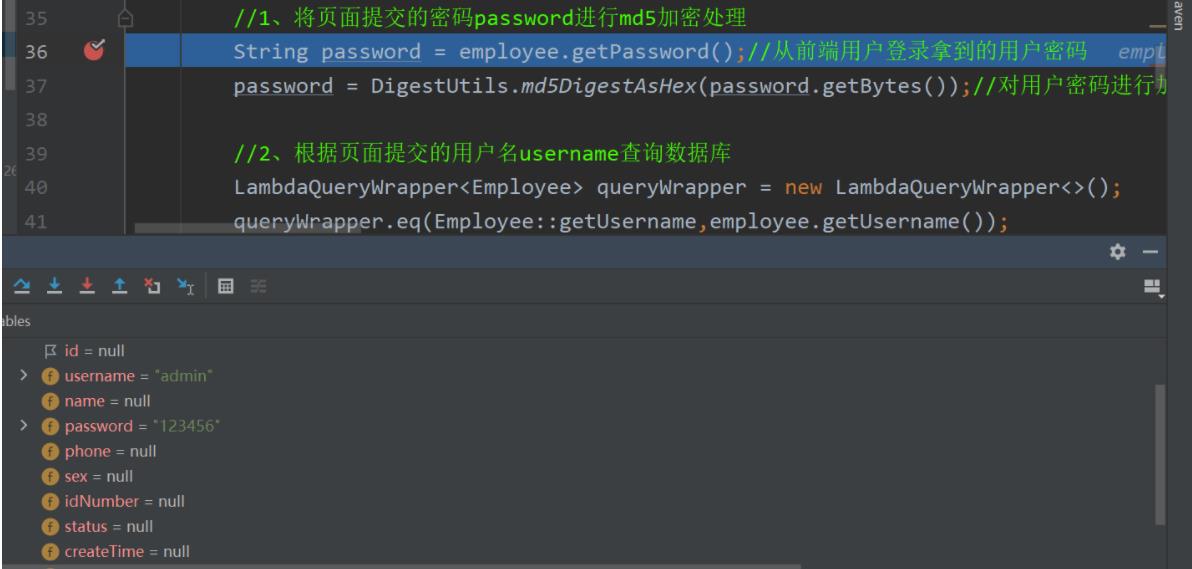 运行成功后:(这个密码是123456),数据存在了浏览器中:这个代码是吧返回的数据保持在浏览器中:
运行成功后:(这个密码是123456),数据存在了浏览器中:这个代码是吧返回的数据保持在浏览器中:
localStorage.setItem('userInfo',JSON.stringify(res.data))在浏览器我们可以看见,key为userInfo,value为我们返回的数据;

五、后台系统退出功能
点击退出按钮,发送退出的请求:http://localhost:8080/employee/logout

后端代码处理:
①在controller中创建对应的处理方法来接受前端的请求,请求方式为post;
②清理session中的用户id
③返回结果(前端页面会进行跳转到登录页面)
前端代码,也要把浏览器中的数据给清除;

/**
* 退出功能
* ①在controller中创建对应的处理方法来接受前端的请求,请求方式为post;
* ②清理session中的用户id
* ③返回结果(前端页面会进行跳转到登录页面)
* @return
*/
@PostMapping("/logout")
public R<String> logout(HttpServletRequest request)
//清理session中的用户id
request.getSession().removeAttribute("employee");
return R.success("退出成功");
功能测试:先登陆,然后退出即可;看浏览器中的数据是否会被清除;
六、员工管理模块
完善登陆功能
问题分析:前面的登陆存在一个问题,如果用户不进行登陆,直接访问系统的首页,照样可以正常访问,这种设计是不合理的,我们希望看到的效果是只有完成了登陆后才可以访问系统中的页面,如果没有登陆则跳转到登陆页面;
那么如何实现?
答案就是使用过滤器或者是拦截器,在拦截器或者是过滤器中判断用户是否已经完成了登陆,如果没有登陆则跳转到登陆页面;
代码实现:这里使用的是过滤器;
①创建自定义过滤器LongCheckFilter
package com.itheima.reggie.filter;
import lombok.extern.slf4j.Slf4j;
import javax.servlet.*;
import javax.servlet.annotation.WebFilter;
import javax.servlet.http.HttpServletRequest;
import javax.servlet.http.HttpServletResponse;
import java.io.IOException;
/**
* @author LJM
* @create 2022/4/15
* 检查用户是否已经完成登陆
* filterName过滤器名字
* urlPatterns拦截的请求,这里是拦截所有的请求
*
*/
@WebFilter(filterName = "LongCheckFilter",urlPatterns = "/*")
@Slf4j
public class LongCheckFilter implements Filter
@Override
public void doFilter(ServletRequest servletRequest, ServletResponse servletResponse, FilterChain filterChain) throws IOException, ServletException
HttpServletRequest request = (HttpServletRequest) servletRequest;
HttpServletResponse response = (HttpServletResponse) servletResponse;
log.info("拦截到的请求:",request.getRequestURL());
//对请求进行放行
filterChain.doFilter(request,response);
②在启动类加上注解@ServletComponentScan
然后先测试一下过滤器能不能生效,具体的逻辑等下再书写;发送请求,看后台能不能打印拦截的信息:

③完善过滤器的处理逻辑

具体逻辑的代码实现:
package com.itheima.reggie.filter;
import com.alibaba.fastjson.JSON;
import com.itheima.reggie.common.R;
import lombok.extern.slf4j.Slf4j;
import org.springframework.util.AntPathMatcher;
import javax.servlet.*;
import javax.servlet.annotation.WebFilter;
import javax.servlet.http.HttpServletRequest;
import javax.servlet.http.HttpServletResponse;
import java.io.IOException;
/**
* @author LJM
* @create 2022/4/15
* 检查用户是否已经完成登陆
* filterName过滤器名字
* urlPatterns拦截的请求,这里是拦截所有的请求
*
*/
@WebFilter(filterName = "LongCheckFilter",urlPatterns = "/*")
@Slf4j
public class LongCheckFilter implements Filter
//路径匹配器,支持通配符
public static final AntPathMatcher PATH_MATCHER = new AntPathMatcher();
@Override
public void doFilter(ServletRequest servletRequest, ServletResponse servletResponse, FilterChain filterChain) throws IOException, ServletException
//对请求和响应进行强转,我们需要的是带http的
HttpServletRequest request = (HttpServletRequest) servletRequest;
HttpServletResponse response = (HttpServletResponse) servletResponse;
//1、获取本次请求的URI
String requestURL = request.getRequestURI();
//定义不需要处理的请求路径 比如静态资源(静态页面我们不需要拦截,因为此时的静态页面是没有数据的)
String[] urls = new String[]
"/employee/login",
"/employee/logout",
"/backend/**",
"/front/**"
;
//做调试用的
//log.info("拦截到请求:",requestURL);
//2、判断本次请求是否需要处理
boolean check = check(urls, requestURL);
//3、如果不需要处理,则直接放行
if(check)
//log.info("本次请求不需要处理",requestURL);
filterChain.doFilter(request,response);
return;
//4、判断登录状态,如果已登录,则直接放行
if(request.getSession().getAttribute("employee") != null)
//log.info("用户已登录,用户id为:",request.getSession().getAttribute("employee"));
filterChain.doFilter(request,response);
return;
//log.info("用户未登录");
//5、如果未登录则返回未登录结果,通过输出流方式向客户端页面响应数据,具体响应什么数据,看前端的需求,然后前端会根据登陆状态做页面跳转
response.getWriter().write(JSON.toJSONString(R.error("NOTLOGIN")));
return;
/**
* 路径匹配,检查本次请求是否需要放行
* @param urls
* @param requestURI
* @return
*/
public boolean check(String[] urls,String requestURI)
for (String url : urls)
//把浏览器发过来的请求和我们定义的不拦截的url做比较,匹配则放行
boolean match = PATH_MATCHER.match(url, requestURI);
if(match)
return true;
return false;
功能测试: 发起几个请求看看后台的输出,和能不能访问到资源里面的数据,和能不能跳转,注意,上面的后台日志代码已经被注释,需要在后台看到日志的话,需要把注释去掉;
新增员工

数据模型:
新增员工,其实就是将我们的新增页面录入的员工数据插入到employee表;注意:employee表中对username字段加入了唯一的约束,因为username是员工的登陆账号,必须是唯一的!

employee表中的status字段默认设置为1,表示员工状态可以正常登陆;

代码开发:
梳理一下代码执行的流程:

/**
* 新增员工
* @param employee
* @return
*/
@PostMapping()//因为请求就是 /employee 在类上已经写了,所以咱俩不用再写了
public R<String> save(HttpServletRequest request,@RequestBody Employee employee)
//对新增的员工设置初始化密码123456,需要进行md5加密处理,后续员工可以直接修改密码
employee.setPassword(DigestUtils.md5DigestAsHex("123456".getBytes()));
employee.setCreateTime(LocalDateTime.now());
employee.setUpdateTime(LocalDateTime.now());
//获得当前登录用户的id
Long empId = (Long) request.getSession().getAttribute("employee");
employee.setCreateUser(empId); //创建人的id,就是当前用户的id(在进行添加操作的id)
employee.setUpdateUser(empId);//最后的更新人是谁
//mybatis提供的新增方法
employeeService.save(employee);
return R.success("新增员工成功");
功能测试:登陆之后,点击添加,然后确认,然后去数据库看一下新增数据成功没,新增成功,那就表示代码可以执行; 注意:但是因为我们把username设置为唯一索引,所以下次再新增用户的时候,就会出现异常,这个异常是MySQL数据库抛出来的;
解决bug:

全局异常捕获
这个全局异常捕获写在common包下;
package com.itheima.reggie.common;
import lombok.extern.slf4j.Slf4j;
import org.springframework.stereotype.Controller;
import org.springframework.web.bind.annotation.ControllerAdvice;
import org.springframework.web.bind.annotation.ExceptionHandler;
import org.springframework.web.bind.annotation.ResponseBody;
import org.springframework.web.bind.annotation.RestController;
import java.sql.SQLIntegrityConstraintViolationException;
/**
* @author LJM
* @create 2022/4/15
* 全局异常处理
*/
@ControllerAdvice(annotations = RestController.class, Controller.class) //表示拦截哪些类型的controller注解
@ResponseBody
@Slf4j
public class GlobalExceptionHandler
/**
* 处理SQLIntegrityConstraintViolationException异常的方法
* @return
*/
@ExceptionHandler(SQLIntegrityConstraintViolationException.class)
public R<String> exceptionHandle(SQLIntegrityConstraintViolationException exception)
log.error(exception.getMessage()); //报错记得打日志
if (exception.getMessage().contains("Duplicate entry"))
//获取已经存在的用户名,这里是从报错的异常信息中获取的
String[] split = exception.getMessage().split(" ");
String msg = split[2] + "这个用户名已经存在";
return R.error(msg);
return R.error("未知错误");
功能测试:登陆后,添加一个一个已经存在账号名,看前端页面提示的是什么信息,以及看后台是否输出了报错日志;


员工信息分页查询
需求分析:系统中的员工比较多的时候,如果在一个页面中全部展示出来会显得比较乱,不便于查看,所以一般都系统中都会以分页的方式来展示列表数据。

流程分析:
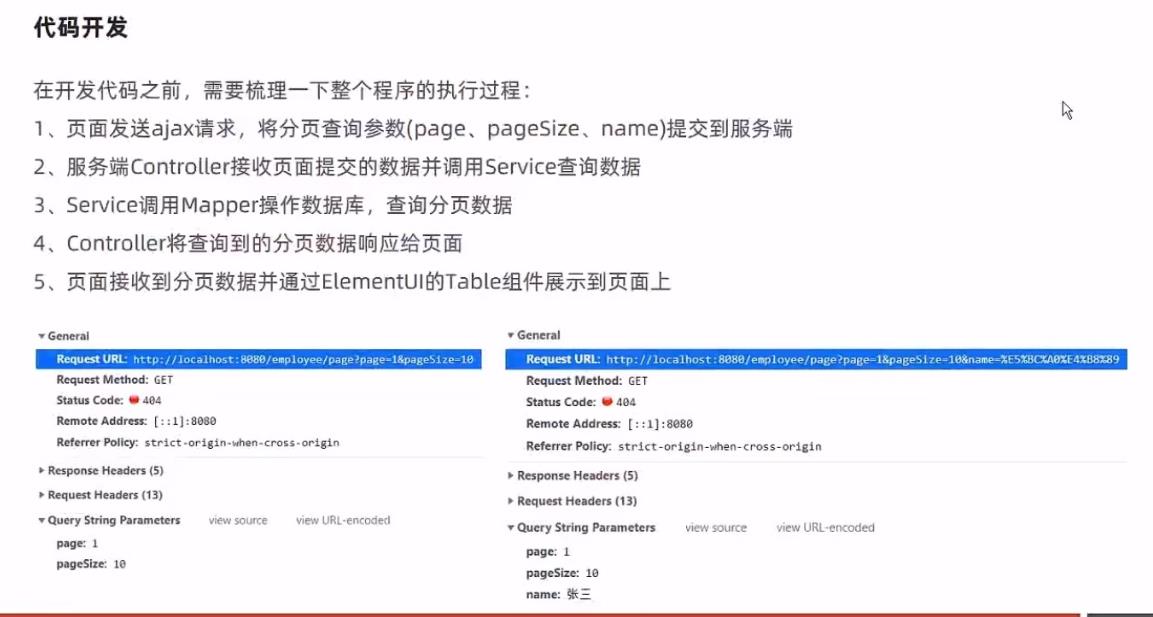
Java代码:
//配置mybatis-plus的分页插件
package com.itheima.reggie.config;
import com.baomidou.mybatisplus.extension.plugins.MybatisPlusInterceptor;
import com.baomidou.mybatisplus.extension.plugins.inner.PaginationInnerInterceptor;
import org.springframework.context.annotation.Bean;
import org.springframework.context.annotation.Configuration;
/**
* @author LJM
* @create 2022/4/15
* 配置mybatis-plus提供的分页插件拦截器
*/
@Configuration
public class MybatisPlusConfig
@Bean
public MybatisPlusInterceptor mybatisPlusInterceptor()
MybatisPlusInterceptor mybatisPlusInterceptor = new MybatisPlusInterceptor();
mybatisPlusInterceptor.addInnerInterceptor(new PaginationInnerInterceptor());
return mybatisPlusInterceptor;
/**
* 员工信息分页
* @param page 当前页数
* @param pageSize 当前页最多存放数据条数,就是这一页查几条数据
* @param name 根据name查询员工的信息
* @return
*/
@GetMapping("/page")
public R<Page> page(int page,int pageSize,String name)
//这里之所以是返回page对象(mybatis-plus的page对象),是因为前端需要这些分页的数据(比如当前页,总页数)
//在编写前先测试一下前端传过来的分页数据有没有被我们接受到
//log.info("page = ,pageSize = ,name = " ,page,pageSize,name);
//构造分页构造器 就是page对象
Page pageInfo = new Page(page,pageSize);
//构造条件构造器 就是动态的封装前端传过来的过滤条件 记得加泛型
LambdaQueryWrapper<Employee> queryWrapper = new LambdaQueryWrapper();
//根据条件查询 注意这里的条件是不为空
queryWrapper.like(StringUtils.isNotEmpty(name),Employee::getName,name);
//添加一个排序条件
queryWrapper.orderByDesc(Employee::getUpdateTime);
//执行查询 这里不用封装了mybatis-plus帮我们做好了
employeeService.page(pageInfo,queryWrapper);
return R.success(pageInfo);
功能测试:分页的三个时机,①用户登录成功时,分页查询一次 ②用户使用条件查询的时候分页一次 ③跳转页面的时候分页查询一次
启用/禁用员工账号
需求分析:
在员工管理列表页面中,可以对某个员工账号进行启用或者是禁用操作。账号禁用的员工不能登陆系统,启用后的员工可以正常登陆;
需要注意的是:只有管理员(admin用户)才可以对其他普通用户进行启用操作,禁用操作,所以普通用户登录系统后启用,禁用按钮不显示;
并且如果某个员工账号的状态为正常,则按钮显示为’‘禁用’,如果员工账号状态为已禁用,则按钮显示为“启用”。
普通员工登录系统后,启用,禁用按钮不显示;
代码开发:

注意:这里修改状态码要反着来,因为正常的用户你只能把它设置为禁用;已经禁用的账号你只能把它设置为正常

流程分析:

注意:启用,禁用的员工账号,本质上就是一个更新操作,也就是对status状态字段进行修改操作;
在controller中创建update方法,此方法是一个通用的修改员工信息的方法,因为status也是employee中的一个属性而已;这里使用了动态SQL的功能,根据具体的数据修改对应的字段信息;
/**
* 根据id修改员工信息
* @param employee
* @return
*/
@PutMapping
public R<String> update(HttpServletRequest request,@RequestBody Employee employee)
log.info(employee.toString());
Long empId = (Long)request.getSession().getAttribute("employee");
employee.setUpdateTime(LocalDateTime.now());
employee.setUpdateUser(empId);
employeeService.updateById(employee);
return R.success("员工信息修改成功");
功能测试:测试的时候我们发现出现了问题,就是我们修改员工的状态,提示信息显示修改成功,但是我们去数据库查验证的时候,发现员工的状态码压根就没有变化,这是为什么呢?

仔细观察id后,我们会发现后台的SQL语句使用的id和数据库中的id是不一样的!
原因是:mybatis-plus对id使用了雪花算法,所以存入数据库中的id是19为长度,但是前端的js只能保证数据的前16位的数据的精度,对我们id后面三位数据进行了四舍五入,所以就出现了精度丢失;就会出现前度传过来的id和数据里面的id不匹配,就没办法正确的修改到我们想要的数据;
当然另一种解决bug的方法是:关闭mybatis-plus的雪花算法来处理ID,我们使用自增ID的策略来往数据库添加id就行;
使用自定义消息转换器
代码bug修复:
思路:既然js对long型的数据会进行精度丢失,那么我们就对数据进行转型,我们可以在服务端(Java端)给页面响应json格式的数据时进行处理,将long型的数据统一转换为string字符串;
代码实现步骤:

步骤一:自定义消息转换类
package com.itheima.reggie.common;
import com.fasterxml.jackson.databind.DeserializationFeature;
import com.fasterxml.jackson.databind.ObjectMapper;
import com.fasterxml.jackson.databind.module.SimpleModule;
import com.fasterxml.jackson.databind.ser.std.ToStringSerializer;
import com.fasterxml.jackson.datatype.jsr310.deser.LocalDateDeserializer;
import com.fasterxml.jackson.datatype.jsr310.deser.LocalDateTimeDeserializer;
import com.fasterxml.jackson.datatype.jsr310.deser.LocalTimeDeserializer;
import com.fasterxml.jackson.datatype.jsr310.ser.LocalDateSerializer;
import com.fasterxml.jackson.datatype.jsr310.ser.LocalDateTimeSerializer;
import com.fasterxml.jackson.datatype.jsr310.ser.LocalTimeSerializer;
import java.math.BigInteger;
import java.time.LocalDate;
import java.time.LocalDateTime;
import java.time.LocalTime;
import java.time.format.DateTimeFormatter;
import static com.fasterxml.jackson.databind.DeserializationFeature.FAIL_ON_UNKNOWN_PROPERTIES;
/**
* 对象映射器:基于jackson将Java对象转为json,或者将json转为Java对象
* 将JSON解析为Java对象的过程称为 [从JSON反序列化Java对象]
* 从Java对象生成JSON的过程称为 [序列化Java对象到JSON]
*/
public class JacksonObjectMapper extends ObjectMapper
public static final String DEFAULT_DATE_FORMAT = "yyyy-MM-dd";
public static final String DEFAULT_DATE_TIME_FORMAT = "yyyy-MM-dd HH:mm:ss";
public static final String DEFAULT_TIME_FORMAT = "HH:mm:ss";
public JacksonObjectMapper()
super();
//收到未知属性时不报异常
this.configure(FAIL_ON_UNKNOWN_PROPERTIES, false);
//反序列化时,属性不存在的兼容处理
this.getDeserializationConfig().withoutFeatures(DeserializationFeature.FAIL_ON_UNKNOWN_PROPERTIES);
SimpleModule simpleModule = new SimpleModule()
.addDeserializer(LocalDateTime.class, new LocalDateTimeDeserializer(DateTimeFormatter.ofPattern(DEFAULT_DATE_TIME_FORMAT)))
.addDeserializer(LocalDate.class, new LocalDateDeserializer(DateTimeFormatter.ofPattern(DEFAULT_DATE_FORMAT)))
.addDeserializer(LocalTime.class, new LocalTimeDeserializer(DateTimeFormatter.ofPattern(DEFAULT_TIME_FORMAT)))
.addSerializer(BigInteger.class, ToStringSerializer.instance)
.addSerializer(Long.class, ToStringSerializer.instance)
.addSerializer(LocalDateTime.class, new LocalDateTimeSerializer(DateTimeFormatter.ofPattern(DEFAULT_DATE_TIME_FORMAT)))
.addSerializer(LocalDate.class, new LocalDateSerializer(DateTimeFormatter.ofPattern(DEFAULT_DATE_FORMAT)))
.addSerializer(LocalTime.class, new LocalTimeSerializer(DateTimeFormatter.ofPattern(DEFAULT_TIME_FORMAT)));
//注册功能模块 例如,可以添加自定义序列化器和反序列化器
this.registerModule(simpleModule);
步骤二:在前面的webMvcConfig 配置类中扩展spring mvc 的消息转换器,在此消息转换器中使用spring提供的对象转换器进行Java对象到json数据的转换;
/**
* 扩展mvc框架的消息转换器
* @param converters
*/
@Override
protected void extendMessageConverters(List<HttpMessageConverter<?>> converters)
//log.info("扩展消息转换器...");
//创建消息转换器对象
MappingJackson2HttpMessageConverter messageConverter = new MappingJackson2HttpMessageConverter();
//设置对象转换器,底层使用Jackson将Java对象转为json
messageConverter.setObjectMapper(new JacksonObjectMapper());
//将上面的消息转换器对象追加到mvc框架的转换器集合中
//转换器是有优先级顺序的,这里我们把自己定义的消息转换器设置为第一优先级,所以会优先使用我们的转换器来进行相关数据进行转换,如果我们的转换器没有匹配到相应的数据来转换,那么就会去寻找第二个优先级的转换器,以此类推
converters.add(0,messageConverter);
然后启动程序,使用f12查看服务器响应到浏览器的用户id是不是变成了字符串,和数据库中是否相对应;
